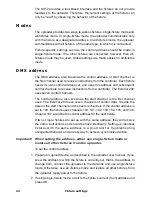
Programming from a PC using MUM
35
When operating multiple fixtures in synchronized-triggering mode, the wait
time in “slave” fixtures is disregarded, and is determined by the triggering, or
“master” fixture. Each fixture fades at its own rate and then waits for the
master to signal a scene, or program, start before continuing.
When programming a triggering (“master”) fixture, keep in mind that its total
scene times should be equal to or longer than the fade times of the other
fixtures. You will get unpredictable results if, for example, a scene is
programmed in the master to last 10 seconds and in other fixtures to fade
for 15 seconds.
Scene management
Once you have specified a mix of effects, you can store the scene using the
options available under the Program menu:
When the program is run, scenes execute in a continuous, ascending loop.
Note that, if a “slave” fixture has:
• Fewer scenes than the master fixture, it will run these in a cycle
continuously, until the master fixture signals that the program should start
from the beginning again.
• More scenes than the master fixture, then the additional scenes will never
run, because the program will reset to the first scene when the master starts
its program from the beginning.
Scene wait
time
This is the duration a color is applied. A wait time can be
from 1 second to 12 hours.
Random
colors
A range of continuously changing color combinations.
Store scene
Save settings in the current scene.
Add scene
Save settings in a new scene at the end of the
sequence.
Insert scene
Save settings in a new scene before the current
scene, which moves up a number.
Tip: Think of the
Add and Insert commands as Save commands, to be
used as the last step after programming all effects.
Delete scene
Remove the current scene from memory. Scenes
above the deleted scene move down a number.
Next scene
Step to the next scene.
Previous
scene
Step to the previous scene.
Delete all
Remove all scenes from the fixture memory.
Run program
Run the scenes in the current program.
Summary of Contents for Exterior 200
Page 1: ...Exterior 200 user manual mar tinar chi tect ura l ...
Page 5: ...5 SECTION 1 GETTING STARTED ...
Page 27: ...General operation 27 SECTION 2 STAND ALONE OPERATION ...
Page 48: ...48 Synchronous triggering during Stand Alone operation ...
Page 49: ...Synchronous triggering during Stand Alone operation 49 SECTION 3 DMX CONTROL ...
Page 53: ...DMX Controller operation 53 SECTION 4 OPTICS ...
Page 57: ...Lens options 57 SECTION 5 SERVICE AND TROUBLESHOOTING ...
Page 65: ...SECTION 6 REFERENCE ...
Page 75: ......
















































